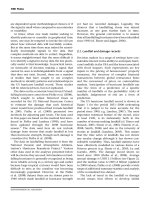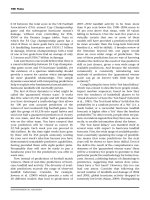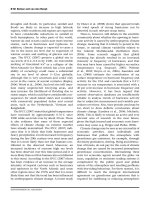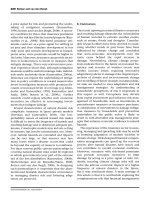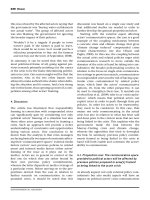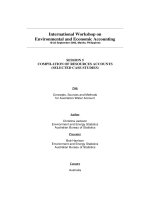Climate change as environmental and economic hazard - phần 2.5
Bạn đang xem bản rút gọn của tài liệu. Xem và tải ngay bản đầy đủ của tài liệu tại đây (292.24 KB, 7 trang )
this was echoed by the affected actors saying that
the government was ‘buying water entitlements
not actual water’. The group of affected actors
was also blaming the government for ignoring
the broader impact of their policies:
Wouldn’t it be a tragedy if people in town
weren’t paid. If the farmer is paid to leave,
there would be no town. So it would just be a
ridiculous proposition to buy out the farmers
and not buy out the town (2 September, 2008).
In summary, it can be noted that this was the
most politicized frame of all, going against pre-
vious research primarily pointing out the causes
of the crisis to be the frame determining politici-
zation in crisis. One reason might well be that the
scientists, who in the two other frames were
allowed to make authoritative claims when defin-
ing the situation and its causes, had a less strong
role in this frame, thus opening up more of a com-
petition among other actors’ framing.
4. Discussion
The article has illustrated that responsibility
framing in connection with compounded crises
can significantly gain by considering not only
political actors’ framing of a situation but also
those other actor groups involved in framing a
crisis. Such an approach will provide a richer
understanding of constraints and opportunities
facing various actors. One conclusion to be
drawn from the analysis is that crisis managers
are facing basically two types of constraints affect-
ing their ‘communicative spaces’: external media
factors (actors’ own previous policies in related
areas) and internal media factors (other actors’
framing of the issue as it plays out in the
media). Actors are in general in control of the
first one (in which they are rather bound by
their own previous policy commitments),
whereas the latter depends on media coverage of
a particular event. Before moving on to the pro-
positions derived from the case in relation to
further research on communication in com-
pounded crises, it should be noted that this
discussion was based on a single case study and
that additional studies are needed in order to
further develop the general propositions below.
Starting with the external aspect affecting
actors’ communicative spaces, the case is a good
example of the coupling mechanism between
a concrete crisis and climate change that gives
‘climate change induced’ compounded crises
certain characteristics (see also Olsson and
Paglia, 2008). In this case, the coupling between
the actual crisis and related policies urges crisis
communication research to move outside the
domains of the crisis at hand by taking into con-
sideration the broader policymaking context. In
relation to the focus on single crisis communica-
tive settings in previous research, communicators
in compounded crises run the risk of having a par-
ticular crisis contaminated by related policy
issues, which limit the actors’ communicative
options. Or, from the other perspective, it can
be used to strengthen their case. It reminds me
of what Boin et al. (2009) refer to as ‘crisis exploi-
tation’, which means that political actors can
exploit crises in order to push through their pet
policies. In order for actors to be trustworthy,
they need to be consistent. In this case, that
means not only communicating in the actual
crisis but also in relation to what has been said
and done prior to the crisis in areas that are now
being linked to the crisis. This explains why the
government made the link between the
Murray–Darling crisis and climate change,
whereas the opposition first tried to downplay
the link. In summary, previous policy commit-
ments framed as being linked to the crisis at
hand will both enable and constrain the actors’
ability to communicate.
4.1. Proposition one: The communicative space
provided to political actors will be affected by
previous policies proposed in area(s) framed
as being linked to the acute crisis
As already argued, not only external policy com-
mitments but also media aspects will have an
impact on political actors’ crisis communication
236 Olsson
ENVIRONMENTAL HAZARDS
options. This is so because media coverage of
crises consists of a variety of actors involved in
framing the event. In the actual case, the scien-
tists and affected actors were given considerable
space on all three framing themes. As argued by
previous researchers in the field (Weingart et al.,
2000; Andreadis and Smith, 2007), climate
change coverage has moved beyond its previous
occupation with scientific uncertainty into
being reported as foremost a political issue.
However, as can be seen in the empirical analysis,
this does not mean that scientists are not partici-
pating in the debate. On the contrary, it can be
argued that scientists’ framing power becomes
even stronger when there is a consensus on a par-
ticular issue, since it poses limitations on other
actors’ framing options. The fact that the opposi-
tion leader Brendan Nelson came under heavy cri-
ticism for denying the link points to another
important aspect here, that the link between
climate change and extreme weather events has
become stronger, up to the point where it
simply cannot be questioned. Together, the dis-
cussion above stresses the notion that political
actors are constrained by the societal and political
discourse in which they communicate. Given the
strong role of scientists quoted in the news cover-
age, it seems fair to argue that other actors had
less space in framing the issue, as illustrated in
the figures in this analysis, in connection with
framing the severity of the crisis and its causes.
These two factors are vital to responsibility
framing since they limit the range of potential
measures aimed at curbing the crisis. On a more
specific level, there were also examples of when
scientists spoke more directly to politicians.
They were then acting in the capacity of ‘frame
guards’ determined by how other actors ought
to frame the crisis. One example was when the
scientists urged the political actors to stop
arguing over the link between the drought and
climate change for fear that the climate change
issue risked taking over the debate and being
used as an excuse for inaction. The second prop-
osition is then that the participation of other
actors in the media coverage had an impact on
the political actors’ communicative spaces.
More specifically, in relation to ‘climate change
induced’ crises, we can expect scientists to play
an important role in framing the situation and
its causes.
4.2. Proposition two: The strong role of scientists
in framing crisis severity and causes limits
political actors' framing options
Except for scientists, the second most frequently
quoted group was ‘affected actors’, especially
when it came to framing concrete measures. It
might well be the case that interest groups
always play a prominent role in framing measures
in relation to crises, but their strong presence in
this case might likewise rest on the specific cul-
tural Australian context in which farmers and
rural communities have a strong cultural sym-
bolic and economic value. As argued by
Goffman (1981, p. 63), frames are culturally
grounded, making them ‘a central part of a
culture’. According to Botterill (2003), drought
has to be understood as a social construction
and as such highly political in its nature.
However, as argued by West and Smith (1996),
drought is a national symbol of Australia, which
means that in contrast to climate change,
drought policies have not been a politically sensi-
tive issue in Australia, and have not been ques-
tioned in the media debate. Rather, the ‘bush’
and the rural areas have been presented as quin-
tessentially Australian – as an important part of
the national character. In the case study at hand
the actor groups, scientists and affected actors
were basically promoting two different frames
where the first focused on structural adjustments
and the latter on direct effects on rural commu-
nities. Whereas the scientific frame was focused
on long-term impacts and risk assessments, the
coverage of affected communities had much
more of an emotional tone. This was so especially
when individual farmers and their struggles were
being portrayed. This means that even though
the scientific frame had a strong impact in terms
of status and authority, the affected actors’
frame was equally powerful on an emotional
Responsibility framing in a crisis 237
ENVIRONMENTAL HAZARDS
level in relating to fundamental values such
as culture, identity and solidarity. The cultural
framing of measures to cope with the crisis
might then account for why no major policy revi-
sions in terms of what Boin et al. (2008) refer to as
paradigm shifts, involving the altering of funda-
mental normative values, were thoroughly dis-
cussed in the coverage. Rather, the political
framing connected to measures was rather
focused on technical aspects and not the long-
term implications of irrigation agriculture in a
drought-prone area like the Murray–Darling
Basin. This argument leads to the third prop-
osition in relation to responsibility framing of
‘climate change induced’ crises.
4.3. Proposition three: Affected actors with
strong cultural, economic and societal support
will further limit political actors' framing
options in terms of measures aimed at curbing
the crisis
In summary, this paper has argued for research on
crisis communication to take external (outside
the media coverage) as well as internal (inside
the media coverage) factors into account when
examining responsibility frames in connection
with compounded crises. In relation to the rec-
ommendations provided by Boin et al. (2005,
p. 70), stating that successful meaning making
requires the ability to communicate ‘a persuasive
story line that explains what happened, why it
had to be that way, what its repercussions are,
how it can be resolved, who can be relied upon,
and who is to blame’, the article at hand demon-
strates how these storylines are constantly ‘inter-
rupted’ by other actors. As illustrated in this
article, the weight given to each actor group
depends on the issue at hand, where
different groups dominated the frames related
to severity, causes and appropriate measures
respectively. Together, this means that political
actors’ own storylines will be mediated and
finally understood in the light of these other
actors’ framing. The dynamics of this framing
contest will probably look different in various
cultural settings. In order to further develop the
propositions above, additional studies will be
needed.
Notes
1. It should thus be noted that, for example, political
scientists Rosenthal et al. (2001, p. 20) open up a
more dynamic approach to crisis aftermaths,
proposing that ‘Crises mark the transition from
one stable pattern into one of many possible alterna-
tive futures. Actions taken during the crisis process
become defining elements for the (temporary) resol-
ution of that crisis, but at the same time, they
become steps towards the creation of the next crisis.’
2. The Australian reported that ‘Dr Nelson yesterday
denied that he had rejected a link to climate
change.’ ‘That is not what I said’, he told ABC
Radio in Adelaide. But in an interview with ABC pre-
senter Tony Jones on Monday night’s Lateline pro-
gramme, Dr Nelson was asked explicitly whether
he accepted that the Murray crisis was related to
climate change. Dr Nelson replied initially, ‘No, I
do not’ (ABC Radio, 4 September 2008).
3. Cubbie Station is a cotton farm in southern Queens-
land and is Australia’s biggest irrigator, which has
long been accused of taking too much water, in
doing so denying farmers downstream water (ABC,
24 February 2004, www.abc.net.au/7.30/content/
2004/s1052459.htm). In general, Australian cotton
is mostly (82.5 per cent) grown under irrigation.
‘From the growth of the first crop in 1961 –62
near Wee Waa in the Namoi Valley cotton pro-
duction has expanded rapidly to become one of
Australia’s major agricultural industries. It now
makes a major contribution to the economies of
the growing areas and to the Australian economy
as a whole’, www.mdbc.gov.au/subs/eResource_
book/chapter3/p4.htm).
4. The connection between water management and
climate change was justified by the fact that Minister
Penny Wong was the minister for climate change
and water.
5. The Coorong Wetlands are one of the most impor-
tant wetlands in Australia. The wetland consists of
ocean beach, the mouth of the Murray River, lakes
and estuaries. This combination provides a wide
range of habitats that vary from freshwater to hyper-
saline and which are for the most part in a natural
state. The wetlands around the Coorong (including
238 Olsson
ENVIRONMENTAL HAZARDS
Lake Alexandrina and Lake Albert) cover 140,500 ha.
The Coorong is a long, shallow lagoon more than
100 km in length that is separated from the Southern
Ocean by a narrow sand dune peninsula. Lakes
Alexandrina and Albert form the mouth of the
Murray River and are comprised of fresh to saline
waters. The Coorong’s fragile ecology depends on
getting a mix of fresh water from the Murray River
and sea water from the ocean.
References
Andreadis, E. and Smith, J., 2007. Beyond the oozone
layer. British Journalism Review, 18(1). 50–56.
Beck, U., 2002. The terrorist threat: world risk society
revisited. Theory, Culture and Society, 19(4). 3–55.
Beck, U., 2005. Freedom for technology: a call for a
second separation of powers. Dissent, 42(4).
503–507.
Beck, U. and Lau, C., 2005. Second modernity as a
research agenda: theoretical and empirical explora-
tions in the ‘meta-change’ of modern society. The
British Journal of Sociology, 56(4). 526 –557.
Berglez, P., 2008. What is global journalism? Journalism
Studies, 9(6). 845– 858.
Boin, A., ’t Hart, P., Stern, E. and Sundelius, B., 2005. The
Politics of Crisis Management: Public Leadership Under
Pressure. Cambridge University Press, New York, NY.
Boin, A., McConnell, A. and ’t Hart, P., 2008. Governing
After Crisis: The Politics of Investigation, Accountability
and Learning. Cambridge University Press, Cam-
bridge, UK.
Boin, A., McConnell, A. and ’t Hart, P., 2009. Crisis
exploitation: political and policy impacts of
framing contests. Journal of European Public Policy,
16(1). 81– 106.
Botterill, C. L., 2003. Uncertain climate: the recent
history of drought policy in Australia. Australian
Journal of Politics and History, 49(1). 61–74.
Bra
¨
ndstro
¨
m, A. and Kuipers, S., 2003. From ‘normal
incidents’ to ‘political crises’: understanding the
selective politicization of policy failures. Government
and Opposition, 38(3). 279 –305.
Bra
¨
ndstro
¨
m, A., Kuipers, S. and Dale
´
us, P., 2008. The
politics of tsunami responses: comparing patterns
of blame management in scandinavia. Governing
after Crisis: The Politics of Investigation, Accountability
and Learning, A. Boin, A. McConnell and P. ’t Hart.
Cambridge University Press, Cambridge.
Buus, S. and Olsson, E.-K., 2006. The SARS crisis: was
anybody responsible? Journal of Contingencies and
Crisis Management, 14(2). 71–81.
Carvalho, A. and Burgess, J., 2005. Cultural circuits of
climate change in UK broadsheet newspapers,
1985–2003. Risk Analysis, 25(6). 1457–1469.
Coombs, W. T., 1998. An analytical framework for crisis
situations: better responses from a better under-
standing of the situation. Journal of Public Relations
Research 10(3). 177–191.
Coombs, W. T., 2007. Attribution theory as a guide for
post-crisis communication research. Public Relations
Review, 33. 135– 139.
Coombs, W. T. and Holladay, S. J., 2002. Helping crisis
managers protect reputational assets: initial tests of
the situational crisis communication theory. Man-
agement Communication Quarterly, 6(2). 165 –186.
Cox, R., 2007. Crisis disciplines: does environmental
communication have an ethical duty? Environmental
Communication, 1(1). 5–20.
Dear, P., 2006. The Intelligibility of Nature. University of
Chicago Press, Chicago, IL.
De Vries, M. S., 2004. Framing crises: response patterns
to explosions in fireworks factories. Administration
and Society, 36(5). 594–614.
Edelman, M., 1988. Constructing
the
Political Spectacle.
University of Chicago Press, Chicago, IL.
Entman, R. M., 1993. Framing: toward clarification of a
fractured paradigm. Journal of Communication, 43(4).
51–58.
Entman, R. M., 2003. Cascading activation: contesting
the White House’s frame after 9/11. Political Com-
munication, 20(4). 415–432.
Fallows, J. M., 1996. Breaking the News: How the Media
Undermine American Democracy. Pantheon Books,
New York, NY.
Gamson, W., 1992. Talking Politics. Cambridge Univer-
sity Press, Cambridge, UK.
Gamson, W. A., 2004. Bystanders, public opinion and
the media. The Blackwell Companion to Social Move-
ments, D. A. Snow, S. A. Soule and H. Kriesi (eds).
Blackwell, Oxford.
Gamson, W. A. and Stuart, D., 1992. Media discourse as
a symbolic contest: the bomb in political cartoons.
Sociological Forum, 7(1). 1573–7861.
Gerhards, J. and Rucht, D., 1992. Mesomobilization:
organizing and farming in two protest campaigns
in West Germany. American Journal of Sociology,
98(3). 555– 596.
Goffman, E., 1974. Frame Analysis: An Essay on the Organi-
zation of Experience. Northeastern University Press,
Boston, MA.
Responsibility framing in a crisis 239
ENVIRONMENTAL HAZARDS
Goffman, E., 1981. A reply to Denzin and Keller. Con-
temporary Sociology, 10(1). 60–68.
Graber, D., 1988. Processing the News: How People Tame
the Information Tide. Longman, New York, NY.
Graber, D., 1993. Mass Media and American politics.CQ
Press, Washington, DC.
Gurevitch, M. and Levy, M. R., 1985. Introduction. Mass
Communication Yearbook, Vol. 5, M. Gurevitch and
M. R. Levy (eds). Sage, Beverly Hills, CA. 11–22.
Hallahan, K., 1999. Seven models of framing: impli-
cations for public relations. Journal of Public Relations
Research, 11(3). 205–242.
Ihlen, O. and Nitz, M., 2008. Framing contest in
environmental disputes: paying attention to media
and cultural master frames. International Journal of
Strategic Communication, 2(1). 1–18.
Iyengar, S., 1991. Is Anyone Responsible? How Television
Frames Political Issues. University of Chicago Press,
Chicago, IL.
Jamieson, K. H., 2001. Everything You Think You Know
About Politics... And Why You’re Wrong. Basic
Books, New York, NY.
Krosnick, J., Visser, P. and Holbrook, A., 1998. American
opinion on global warming: the impact of the Fall
1997 Debate. Resources, 133. 5–9.
Marcus, A. A. and Goodman, R. S., 1991. Victims and
shareholders: the dilemma of presenting corporate
policy during crisis. Academy of Management Journal,
34(2). 281– 305.
Massey, J. E., 2001. Managing organizational legiti-
macy: communication strategies for organizations
in crisis. Journal of Business Communication, 38(2).
153–182.
McComas, K. and Shanahan, J., 1999. Telling stories
about global climate change: measuring the impact
of narratives on issue cycles. Communication
Research, 26(1). 30–57.
McLeod, J. M., Kosicki, G. M. and McLeod, D. M., 1994.
The expanding boundaries of political communi-
cation effects. Media Effects, J. Bryant and D.
Zillman (eds). Erlbaum, Hillsdale, NJ. 123 –162.
Norris, P., Kern, M. and Just, M. (eds), 2003. Framing Ter-
rorism: The News Media, the Government and the Public.
Routledge, New York and London.
Olsson, E.-K. and Paglia, E., 2008. Global problem –
national accountability: framing accountability in
the Australian context of climate change, communi-
cating climate change. Journal of Contingencies and
Crisis Management, 16(2). 70–79.
Papacharissi, Z. and de Fatima Oliveira, M., 2008. News
frames terrorism: a comparative analysis of frames
employed in terrorism coverage in US and UK
newspapers. The International Journal of Press/Politics,
13(1). 52– 74.
Porfiriev, B., 2000. Preparing for creeping crises: the case
of the Samara region. Journal of Contingencies and
Crisis Management, 8(4). 218–222.
Rosenthal, U., Boin, A. and ’t Hart, P., 2001. The chan-
ging world of crises and crisis management.
Managing Crises: Threats, Dilemmas and Opportunities,
U. Rosenthal, A. Boin and L. Comfort (eds). Charles
C. Thomas, Springfield, IL.
Seeger, M. W., Sellnow, T. L. and Ulmer, R. R., 2003.
Communication and Organizational Crisis. Praeger,
Westport, CT.
Semetko, H. A. and Valkenburg, P. M., 2000. Framing
European politics: a content analysis of press and tele-
vision news. Journal of Communication, 50(2). 93–109.
Shih, T.-J., Wijaya, R. and Brossard, D., 2008. Media
coverage of public health epidemics: linking
framing and issue attention cycle toward an inte-
grated theory of print news coverage of epidemics.
Mass Communication and Society, 11(2). 141–160.
Simonson, P., 1999. Mediated sources of public confi-
dence: Lazarsfeld and Merton revisited. Journal
of
Communication,
49(2). 109–122.
Siomkos, G. and Shrivastava, P., 1993. Responding to
product liability crises. Long Range Planning, 26(5).
72–79.
’t Hart, P., 1993. Symbols, rituals and power: the lost
dimension of crisis management. Journal of Contin-
gencies and Crisis Management, 1(1). 36–50.
’t Hart, P. and Boin, A., 2001. Between crisis and
normalcy: the long shadow of post-crisis politics.
Managing Crises: Threats, Dilemmas and Opportunities,
U. Rosenthal, A. Boin and L. Comfort (eds). Charles
C. Thomas, Springfield, IL.
Ungar, S., 1992. The rise and (relative) decline of global
warming as a social problem. Sociological Quarterly,
33(4). 483– 501.
Ungar, S., 2008. Global bird flu communication: hot
crisis and media reassurance. Science Communication,
29(4). 472– 497.
Weingart, P., Engels, A. and Pansegrau, P., 2000. Risks of
communication: discourses on climate change in
science, politics, and the mass media. Public Under-
standing of Science, 9(3). 261–283.
West, B. and Smith, P., 1996. Drought, discourse, and
Durkheim: a research note. Journal of Sociology,
32(1). 93– 102.
Wolfsfeld, G., 1998. Promoting peace through the
news media. Some initial lessons from the Oslo
peace process. Media, Ritual and Identity, T. Liebes
and J. Curran (eds). Routledge, London.
240 Olsson
ENVIRONMENTAL HAZARDS



